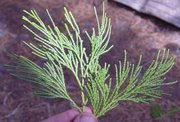Calocedrus
|
|
| Calocedrus | ||||||||||||
|---|---|---|---|---|---|---|---|---|---|---|---|---|
 Calocedrus decurrens (California Incense-cedar) | ||||||||||||
| Scientific classification | ||||||||||||
| ||||||||||||
| Species | ||||||||||||
|
Calocedrus decurrens
Calocedrus formosana
Calocedrus macrolepis
|
Calocedrus is a genus of two to three species of coniferous trees in the cypress family Cupressaceae; the common name is Incense-cedar. The genus is related to the genus Thuja, and like that, has overlapping scale-leaves. Calocedrus differs from Thuja in the scale leaves being in apparent whorls of four (actually opposite decussate pairs like Thuja, but not evenly spaced apart as in Thuja, instead with the successive pairs closely then distantly spaced), and in the cones having just 2-3 pairs of moderately thin, erect scales, rather than 4-6 pairs of very thin scales in Thuja.
Calocedrus decurrens (California Incense-cedar) is native to western North America, with the bulk of the range in the United States, from central western Oregon through most of California and the extreme west of Nevada, and also a short distance into northwest Mexico in northern Baja California. It is a large tree, typically reaching heights of 40-60 m and a trunk diameter of up to 3 m (maxima, 69 m tall and 3.9 m diameter), and with a broad conic crown of spreading branches. The leaves are bright green on both sides of the shoots, and the cones 2-2.5 cm long. It is by far the most widely-known species in the genus, and is often simply called "Incense-cedar" without the regional qualifier.
Calocedrus formosana (Taiwan Incense-cedar) is endemic on Taiwan. It is very similar to C. macrolepis, and some botanists treat it as a variety of that, C. macrolepis var. formosana. It is a medium-size tree, growing to 25-30 m tall, and is rare in the wild, occurring only as scattered trees in mixed forests. The leaves are glaucous green on the upper side of the shoots, and conspicuously marked with bright white stomatal patches on the under side. The cones are 1.5-2 cm long, carried on a 1-1.5 cm stem.
Calocedrus macrolepis (Chinese Incense-cedar) is native to southwest China from Guangdong west to Yunnan, and also in northern Vietnam, northern Laos, extreme northern Thailand and northeastern Myanmar (Burma). It is also a medium-size tree to 25-30 m tall, and like C. formosana, is rare in the wild. The leaves and cones are similar to C. formosana, differing most obviously in the shorter cone stem, only 0.5 cm long.
Uses & Cultivation
The wood of Calocedrus is soft, moderately decay-resistant, and with a strong spicy-resinous fragrance. That of C. decurrens is the primary material for wooden pencils, because it is soft and tends to sharpen easily without forming splinters. The two Asian species were (at least in the past) in very high demand for coffin manufacture in China, due to the scent of the wood and its decay resistance. It is likely that past over-exploitation is responsible for their current rarity.
Calocedrus decurrens is a popular ornamental tree, grown particularly in cool summer climates like Britain and the Pacific Northwest of North America (Washington, British Columbia) for its very narrow columnar crown; this narrow crown is an unexplained consequence of the climatic conditions in these areas, and is not shown by trees in the wild. It is also valued for its drought tolerance. The Asian species are both very rare in cultivation.
External links
Arboretum de Villardebelle - cone photos (http://www.pinetum.org/cones/CUcones.htm)
Gymnosperm Database - Calocedrus (http://www.botanik.uni-bonn.de/conifers/cu/calo/index.htm)fr:Cèdre à encens

